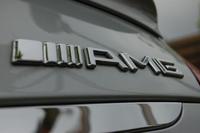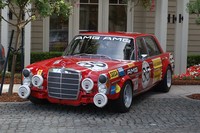AMG At Forty
 |
AMG At Forty
By Carey Russ
Two guys in a garage... it's the proverbial American high-tech success story. It's also the background of AMG, now Mercedes Car Group's wholly-owned high-performance subsidiary. Forty years ago, AMG was, in the then-new company's own words, made of "engineering, construction, and testing specialists in the development of racing engines."
The company name came from the initials of its founders, Hans Werner Aufrecht and Erhard Melcher, and Aufrecht's birthplace, Grossbach, Germany. Not strictly in a garage, but in an old mill in Burgstall, near Affalterbach, AMG built racing cars based on the Mercedes-Benz 300SE sedan, and competed in European touring car races.
The first major success was in the 24-hour endurance race at Spa-Francorchamps, Belgium in 1971, where the AMG-tuned Mercedes 300SEL finished first in class and second overall. That was followed with multiple titles in the German Touring Car (DTM) series and a title in the International Touring Car (ITC) series. When the FIA, the governing body of world motorsport, inaugurated a GT championship series for Grand Touring prototypes based on production cars in 1997, the title went to AMG/Mercedes-Benz for the winning performance of the CLK coupe-based (if loosely) CLK-GTR. The following year, the CLK-GTR won all eleven races of the season. AMG still competes - and wins - in the DTM.
With competition success came a demand for street-legal but distinctively AMG high-performance cars based on Mercedes-Benz sedans. This started quietly in the mid-1970s, and quickly grew. By 1985, AMG had opened a second plant and has grown to employ 100 people. Its products, based on Mercedes-Benz sedans, gained acclaim not only from well-heeled automotive enthusiasts but from celebrities as well. Its first U.S.-legal offering was "The Hammer", based on a 1987 300E and powered by a 360-horsepower 5.6-liter V8.
By 1990 AMG had grown to 400 employees and three factories, large for a tuner and specialty manufacturer but still miniscule compared to the major players. More importantly, at that time AMG and Mercedes-Benz signed a cooperative agreement that allowed AMG products to be sold and maintained through Mercedes-Benz's worldwide dealer network, a decided advantage for a small manufacturer like AMG.
That joint venture soon bore fruit, in the form of 1993's C36 AMG. Further cooperation continued throughout the 1990s, and in 1999 Hans Werner Aufrecht transferred a majority stake in AMG to DaimlerChrysler AG. Aufrecht kept the motorsport department, which became H.W.A., which works closely with Mercedes-Benz Motorsport for DTM projects. Yet more Mercedes-AMG models ensued, and on January 1, 2005 DaimlerChrysler bought the remaining AMG shares to create Mercedes-AMG GmbH.
Today, with the E63 AMG, CLS 63 AMG, S 65 AMG, CL 63 AMG, CLK 63 AMG, SLK 55 AMG, SL 55 AMG, SL 65 AMG, ML 63 AMG, and G 55 AMG there are AMG versions of many of the members of the Mercedes-Benz lineup. Does this reduce exclusivity? Hardly. The cars - and trucks, in the cases of the ML and G - are produced in limited quantities in the old-world manner. Meaning: built to an obsessive degree with an intensive amount of skilled labor. As an example, each engine is assembled by one of a group of 45 master technicians, who then signs a plaque in the engine compartment. Exhaust systems and aerodynamic body parts are unique to AMG, as are modifications to standard Mercedes-Benz automatic transmissions, optimized for higher performance. Brake and suspension upgrades are the result of years of competition experience.
You will notice that in the paragraph above, the number 63 appears rather often. This signifies a new direction for AMG. The twincam, 32-valve 6.3-liter V8 is the first AMG engine not to be based on a Mercedes-Benz powerplant. This helps further differentiate AMG vehicles from their Mercedes counterparts, and points to AMG's future. With horsepower ratings from 475 to well over 500, depending on application, it compares well to the existing AMG/Mercedes supercharged 5.5-liter V8. World emissions requirements are becoming stricter, and the current supercharged AMG engines will soon be unable to meet those requirements.
As part of the celebration of its 40th anniversary, AMG had a display featuring some of its historic and newest cars at the Pebble Beach Concours, near Monterey, CA. After that event, there was a special event for the automotive press a few miles to the north, in Half Moon Bay, CA. The 1971 Spa-winning 300 SEL and some other vintage AMG Benzes were on display, and examples of the E 63, ML 63, and CLK 63 Black Series were available for driving on the local roads.
The E 63 is closest in spirit to the original AMGs, a four-door, five-passenger sedan that combines a level of upscale appointment and comfort that rivals that of a standard Mercedes-Benz with performance potential that can humble many a sports car. It's an iron fist in a velvet glove done the way that the Germans know best, with 507 horsepower, 465 lb-ft of torque, a 4.3-second 0-60 potential, and a (electronically limited) 155-mph top speed. It's also available as a wagon, quite possibly the quickest and fastest production wagon ever, and that is the version I drove first. Verdict: As smooth, quiet, and civilized as any car ever made, and remarkably competent even on the narrow, indifferently-paved roads that veer off California Highway One into the coastal hills. Combine the space and versatility of a wagon - not to mention its relative stealth factor - with serious power and brakes and handling to match, and the E 63 AMG wagon is the most versatile supercar ever made. A fine all-around vehicle for the well-heeled.
Next up was what the AMG representatives called "the ultimate all-rounder AMG", the ML 63. Now, in the wrong hands, "high-performance SUV" is an oxymoron of the highest order. Power added to heavy weight and and a high center of gravity does not necessarily equal excellence in vehicle dynamics. Fortunately, the Mercedes ML is an excellent starting point for a tuner SUV, being as the base ML is quite competent at speed on the road, or even on the track. AMG works its magic to the tune of 503 horsepower and 465 lb-ft, full-time four-wheel drive with three mechanical differentials, and an AMG-tuned fully-independent air suspension.
At 5100 pounds ready to rock and roll, consider it a sumo class rally car, with sub 5-second 0-60 potential and handling that would be considered good for a car half its mass. With a minimum of 7.1 inches of clearance (and a maximum of 11.4) it was the perfect vehicle for the section of pavement on which I drove. I was familiar with that sorry strip of asphalt from riding motorcycles in the area twenty years ago, and it was indifferently paved then. If it had seen maintenance since those days, it hadn't seen much. The frost-heaved roads of the Midwest and East have nothing on California's fine back roads... and when I came over a blind rise to find a four-inch tall lump of pavement in the middle of the road - evidence of soil motion from rain or tectonic forces or a combination thereof - it was not the moment of terror that might have been had I been in a sports car with limited clearance under its vitals. The suspension was stiff enough to limit body roll, all the more noticeable because of the vehicle's height, but it was not at all uncomfortable. Add to its athletic abilities on the road a 5,000-pound towing capacity and spacious five-passenger and cargo interior, and the ML 63 AMG combines sport and utility like nothing else.
The most exclusive, and best, was saved for last. That would be the CLK 63 Black Series, a more limited-production variant of the regular CLK 63 AMG. It improves on the standard CLK 63's 475 horsepower with 500, with the same 465 lb-ft of torque. It's a road-legal replica of the official Formula One safety cars, and as such leverages the look and technology of the racing world. That is far more than skin deep - as in a race car, the suspension is fully adjustable. Probably few of the Black Series CLKs will be used for track days, understandable due to their price and exclusivity, but a shame nonetheless, as the car is meant to be as suited to that as to road use. Outside, with blistered fenders and carbon fiber aerodynamic devices, it looks like a road-legal DTM car. An oil cooler for the differential is hidden in the rear carbon fiber venturi panel.
Inside, it's all business, and the business is fast driving in comfort. To save weight, the CLK's rear seat is removed, and while the appointment level is to the typically high AMG standard, it's far from luxo-tourer opulence - as is correct for its mission. From the factory, the suspension is very, very firm, optimized for racing speeds. Most German high-performance cars are electronically limited to 250 kph - about 155 mph - for top speed; the CLK 63 Black Series goes to 300, or 186 mph. Not that I got within 100 mph of that, or 120 for that matter, such is life in traffic. Acceleration is fierce, with a 0-60 time of 4.1 seconds, and braking and cornering grip easily match that level. The AMG representatives said that the Black Series points toward the future of AMG. That looks like a very good future.



